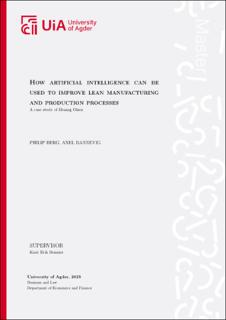| dc.description.abstract | The implementation of Lean and Artificial Intelligence has demonstrated a positive correlation across different industries. By integrating AI techniques, the efficiency and effectiveness of Lean processes can be enhanced. The combination of Lean and AI contributes to improved decision-making, increased productivity, and reduced waste. Moreover, AI can identify and rectify process errors, enabling streamlined and more efficient operations. In 2014, Hennig Olsen initiated the implementation of lean thinking, which yielded mixed results initially. However, they decided to adopt lean principles according to their specific requirements, leading to significantly improved outcomes. With the rapid advancement of technology, Hennig Olsen ventured into experimenting with artificial intelligence, particularly in the realm of vision control, starting in 2019. Subsequently, they have consistently embraced and integrated increasingly advanced technologies to continuously enhance their
production lines.
This case study examined the impact of implementing artificial intelligence on the company’s performance. The findings revealed that as Hennig Olsen incorporated more artificial intelligence into their production lines, they experienced a significant reduction in customer complaints. However, they continue to face challenges in meeting their overall equipment effectiveness goals. The thesis also identified potential areas for improvement, emphasizing the potential benefits of integrating six sigma processes through AI initiatives. More specifically, implementing predictive maintenance to minimize unexpected downtime and improve OEE emerged as a key opportunity. Leveraging AI to analyze vast amounts of data could also prove advantageous in optimizing cycle time and reducing waste within the organization.
Finally, this report has examined the readiness of Hennig Olsen to further integrate AI tools into their operations. To fully capitalize on the potential benefits of AI and evolve into a comprehensive smart factory, the company needs to invest in additional technologies such as the Internet of Things, big data analytic, and cloud computing. However, a significant hurdle arises from the limitations of their existing machinery, which cannot gather extensive data or establish interconnectivity. Moreover, sourcing qualified personnel proficient in developing these technologies poses a challenge. A more effective strategy, along with support from stakeholders, is necessary to encourage investments in new technologies. This will facilitate the successful implementation of AI technologies and foster improved acceptance of new technology among employees. | |
